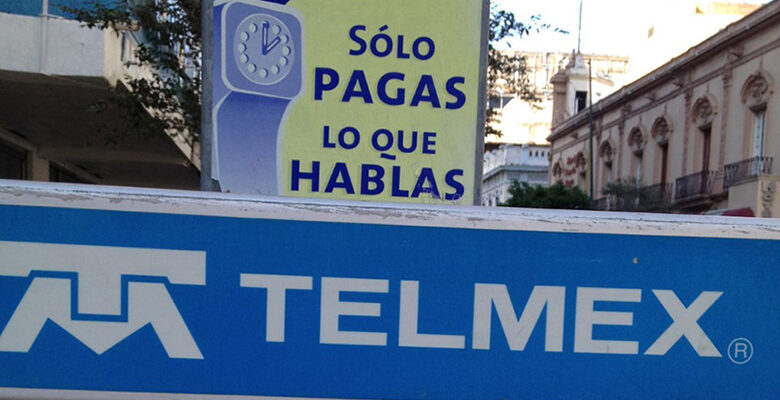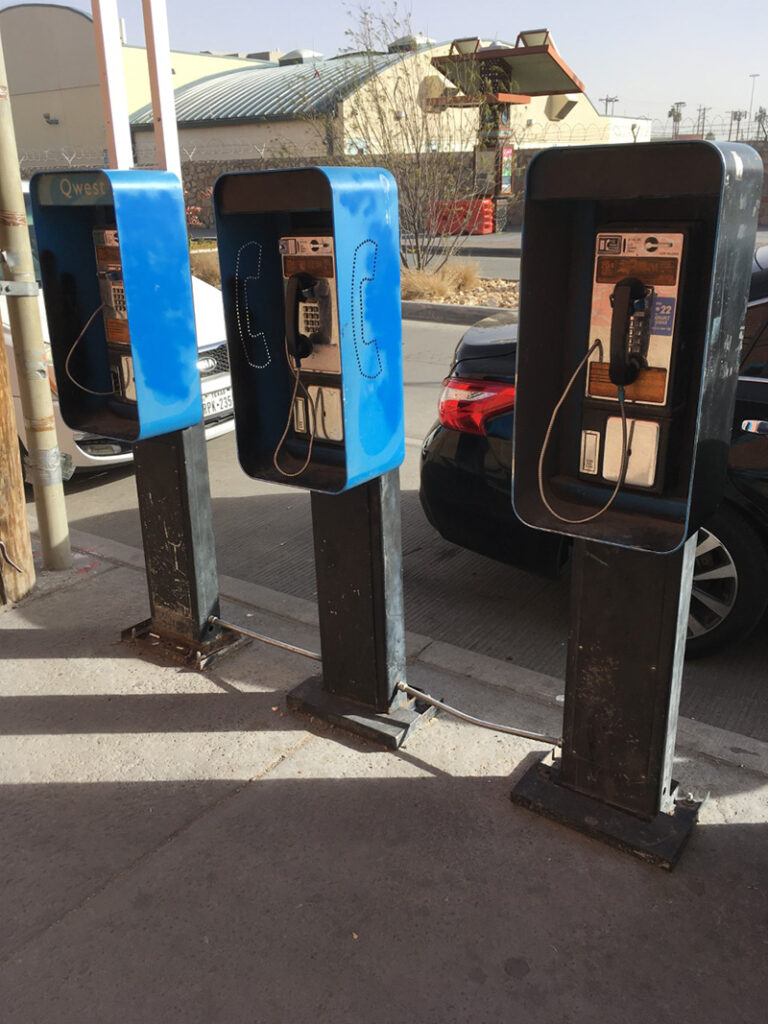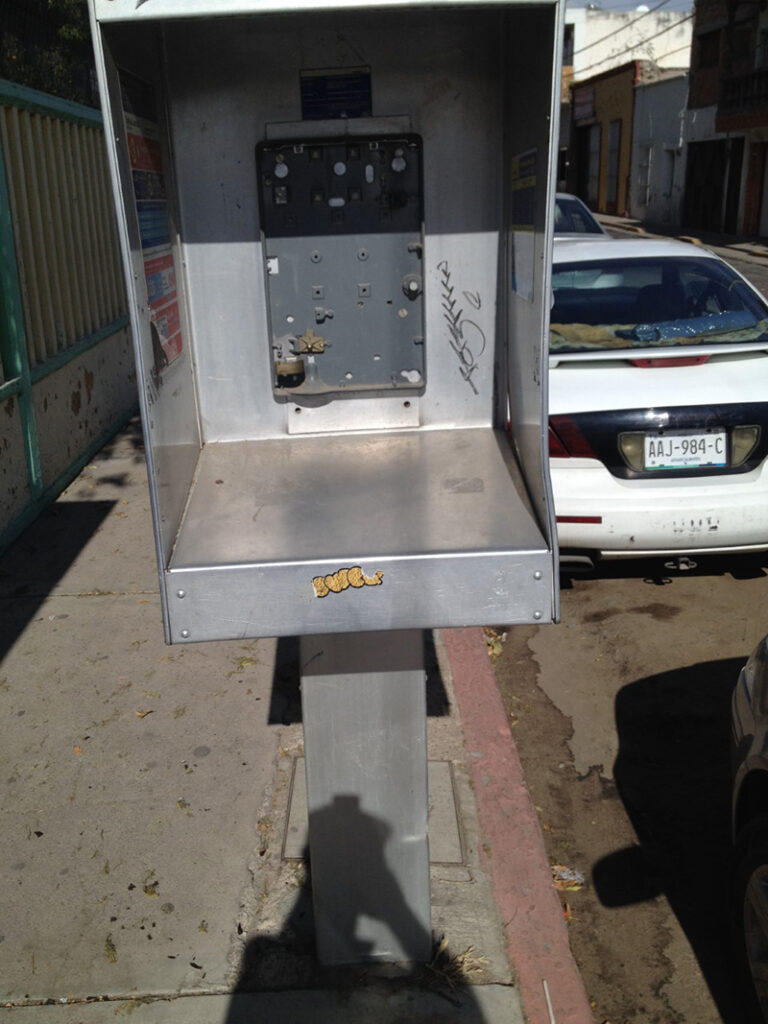By Kent Paterson
They stand on an El Paso street like the shadowy, eerie artifacts of a forgotten ancient civilization. Clumped together in a threesome at the foot of the U.S. side of the Paso del Norte Bridge, aka Santa Fe Bridge, the three old pay phone booths evoke the voices of ghosts forever curdling the borderland. Though none of the devices inside the booths actually works, their mere presence triggers memories of glorious and not so glorious times.
At one time there was an entire wall of pay phones fronting the three mummified wonders. This became a lively place frequented by migrants and travelers arranging rides, lovers rekindling or extinguishing affairs, second-hand shoppers and duty-free dealers, and entrepreneurs conducting business- legal or otherwise.
Back in the days of the pre-NAFTA Chile Boom in New Mexico, farmworkers gathered nearby in the dead of the night for the arrival of labor contractors’ buses that hauled them back and forth from the fields for seasonal rounds of generous labor and scanty compensation.
On this block taxistas quoting Filet Mignon fares hustled passengers to the airport, an overzealous cop yelled at real or perceived jaywalkers (once even threatening to dispatch the sassy writer to the hoosegow!), bums begged change, and returning Juárez revelers could barf up the contents of an evening’s outing instead of ruining the new floor at home. Dreams of the Duke City, Denver, Dallas and Dalia, not to mention Del Rio and Delicias, were made or broken here.
One legendary day a harried man barked into a pay phone at an unknown nemesis or demon or phantom on the other line, spilling his deranged guts and shouting out an impossibly tangled up life story louder than the backfiring mufflers descending from the international bridge.
The Place of the Three Mummies is a rare space where life’s triumphs and failures, trials and tribulations, ecstasies and calamities, converge on a single electric block. Do you remember when a dime or quarter delivered a ride to heaven or a jaunt to hell? Rumor has it that there is a pay phone or two somewhere out there in 21st Century El Chuco that actually works.
The pay phone had a longer run in Mexico than in the United States, and even today the lucky traveler may run across one of God’s fine inventions here and there. But for the most part, working pay phones south of the border are relics of history too.
The big difference between the two countries is that the shell of the pay phone is an ubiquitous feature of the Mexican landscape. Imagine a nation paved with endless tortoise shells without the tortoise. Or a million armadillo shells minus the creature sculpting street corners all the way from the northern border with Gringolandia to the southern frontier with Central America.
In large measure, the surviving pay phone and booth is the legacy of Mr. Carlos Slim and the Great Privatization Era of the late 1900s when once nationally-owned enterprises (in this case Telmex) made fortunes for men like Slim.
Refashioning the national exterior in a post-modern aesthetic, Mr. Slim and company replaced the dusty old pay phones of government mint with modern ones that ultimately operated with pre-purchased cards whose designs and artwork rivaled or beat out the finest of baseball card collections.
Especially in bustling centers, a certain etiquette accompanied pay phone usage. If a caller hogged a phone for more than a couple of minutes, he or she might feel the impatient breathes and murmurs of the growing line of desperate people. Physical and vocal rituals also evolved as the modernized fleet of pay phones fell into disrepair and suffered corporate neglect.
Prone to momentary or permanent malfunctions, Telmex booths were the scene of kicking, banging, shaking and rattling movements. Screaming, pleading, praying and cussing were fairly common vocalizations heard around a typical booth. Think of attempting to raise the dead.
The pay phone was living on borrowed time, soon to be replaced by the cell phone, which of course was another great source of Mr. Slim’s and his crew’s profits.
Unlike the demise of the pay phone in the United States, however, the virtual disappearance of the pay phone in Mexico did not mean the elimination of the pay phone booth, which turned out to have great utilitarian value.
Life’s great battery of fables, fantasies and follies can still be found on pay phone booths. Besides serving as a trash receptacle, pay phone booths might contain flyers advertising jobs or schools, give contacts for fortune tellers, host posters of missing persons, and feature fraud vibe ads for group vacations to a beach in Paradise. As they say, if the price sounds too good to be true….
Street art, crude graffiti, and plain old nasty words often decorate the interiors and exteriors of Telmex’s old one armed bandits now converted into outlets for popular expression.
And in electoral times, passerby are almost certain to encounter political messages plastered in and on phone booths. Many Mexicans consider these remnants of an earlier age nuisances and eyesores which should duly be consigned to the trash heap of history.
Yet for some reason the phone booth remains part of the landscape, part of the national patrimony. Perhaps the voices of ghosts never really fade away.






When was the last time you saw a juke box in a honky-tonk?